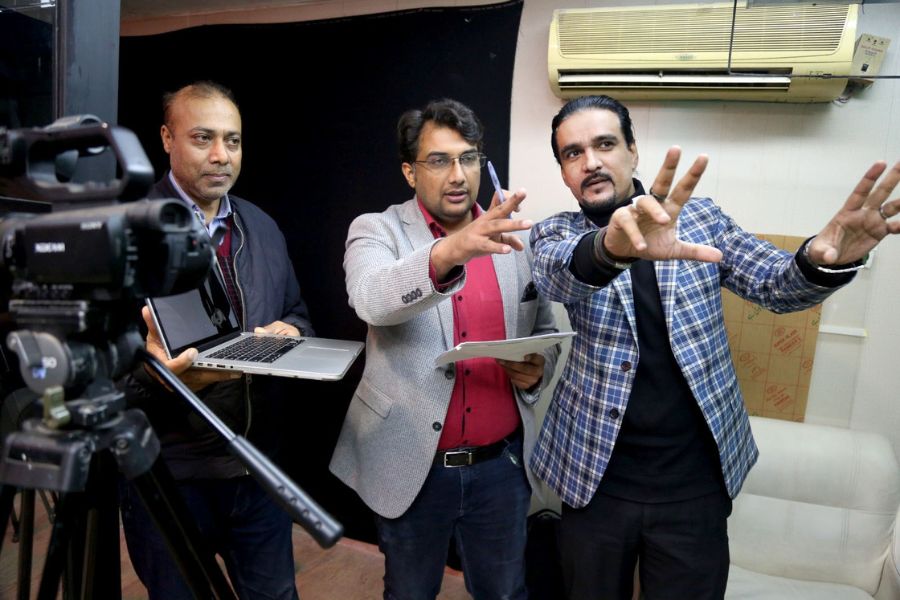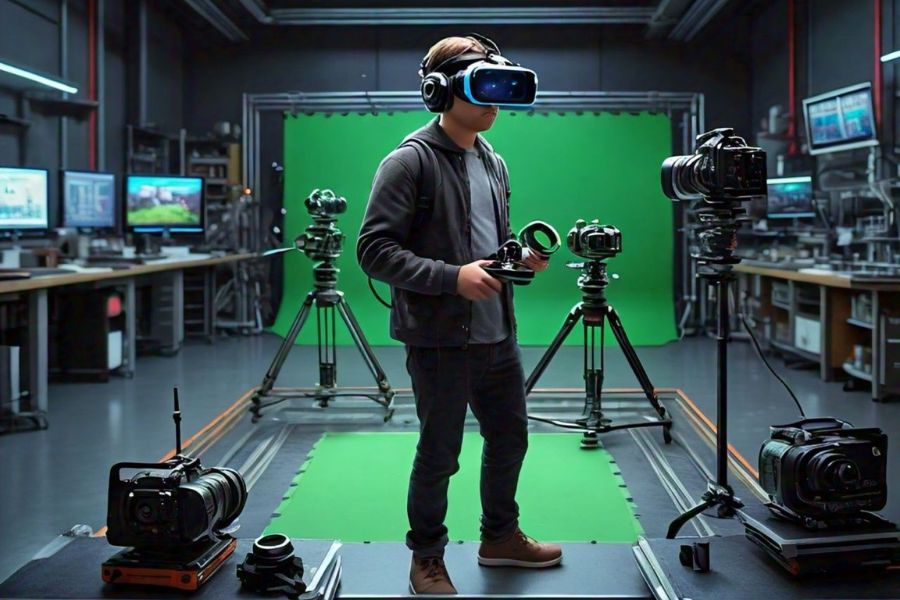Table of Contents
Introduction
Welcome to the exciting world of Virtual Reality (VR) filmmaking! As technology continues to evolve, VR filmmaking is becoming an increasingly significant part of the industry, offering unique ways to tell stories and engage audiences. In this comprehensive guide, we’ll dive into the virtual reality filmmaking basics, covering everything from 360 video capture to VR storytelling techniques, VR filmmaking equipment, post-production for VR films.
Understanding Virtual Reality Filmmaking Basics

Definition of Virtual Reality Filmmaking
Virtual reality filmmaking is the process of creating immersive video content that allows viewers to experience a story or environment in a fully interactive way. Unlike traditional films, VR films place the audience in the center of the action, giving them the ability to look around and explore the scene from multiple angles. Allows viewers to feel like they’re truly “in” the story.
Differences Between Traditional and VR Filmmaking
While traditional filmmaking uses a linear narrative structure, VR filmmaking requires a more dynamic approach. Directors need to consider the 360-degree environment and how viewers will interact with it. This often means creating multiple points of interest and ensuring the story can be understood from any perspective.
Traditional Films: Linear narrative, fixed perspective for the viewer. Think of watching a movie in a theater.
VR Films: Dynamic and interactive. Directors need to consider the entire 360-degree environment and how viewers will navigate it. Imagine exploring a virtual world where you can look up, down, and all around.
Benefits of VR Filmmaking
The immersive nature of VR filmmaking can make stories more engaging and impactful. It allows for a greater sense of presence and emotional connection, which can enhance the storytelling experience. Additionally, VR films can be used for various applications, including education, training, marketing, and entertainment.
Increased Engagement: VR’s immersive nature makes stories more captivating and impactful.
Stronger Emotional Connection: Feeling “present” in the story fosters a deeper emotional connection with the characters and events.
Diverse Applications: VR films can be used for education (e.g., virtual field trips), training (e.g., medical simulations), marketing (e.g., product demos), and of course, entertainment (e.g., VR games, interactive films).
360 Video Capture
What is 360 Video?
360 video is a type of video recording where every direction is recorded simultaneously, providing a spherical video that the viewer can look around in. This is achieved using specialized cameras that capture footage in a full 360-degree view.
Equipment for 360 Video Capture
To capture 360 video, you’ll need a 360-degree camera. Popular choices include the GoPro MAX (This is a popular choice for action-packed 360 capture.), Insta360 One X2 (Another well-regarded option known for its ease of use.), and the Ricoh Theta V (A compact and affordable option for beginners.). These cameras come with multiple lenses to cover the entire spherical range. Additionally, you’ll need a sturdy tripod or monopod and possibly a drone for aerial shots.
Tips for Effective 360 Video Capture
- Stabilize Your Shots: Use a tripod or monopod to keep your camera steady.
- Plan Your Scenes: Consider how the viewer will interact with the environment.
- Mind the Stitch Lines: Ensure your camera setup minimizes visible stitch lines.
- Test Your Shots: Always preview your footage in a VR headset to check for any issues.
VR Storytelling Techniques
Immersive Storytelling in VR
Immersive storytelling in VR goes beyond traditional narrative methods. It requires thinking about how to engage the audience within a 360-degree space. This often involves using spatial audio, interactive elements, and multiple focal points to guide the viewer’s attention.
Engaging the Audience in a VR Environment
To keep viewers engaged in a VR environment, you need to create a sense of presence. This can be achieved through realistic environments, relatable characters, and interactive elements that allow viewers to feel part of the story. Think of it like being a tour guide within your narrative world.
Examples of Successful VR Storytelling
- “The Invisible Man”: This VR film uses a compelling narrative and interactive elements to immerse viewers in the story of a disappearing man.
- “The Protectors”: A VR documentary that puts viewers in the shoes of African rangers protecting elephants from poachers.
- “Wolves in the Walls”: A VR experience based on Neil Gaiman’s story, blending storytelling with interactive VR elements.
VR Filmmaking Equipment
Essential VR Filmmaking Gear
To create high-quality VR films, you’ll need several pieces of essential gear:
- 360-Degree Cameras: As mentioned, options like the GoPro MAX and Insta360 One X2 are popular choices.
- Tripods and Mounts: For stable footage.
- Drones: For capturing aerial shots.
- Lighting Equipment: To ensure your scenes are well-lit.
Cameras and Rigs
Cameras such as the Z Cam S1 and the Vuze XR offer advanced features for professional VR filmmaking. Rigs are also essential for mounting multiple cameras together to capture 360-degree footage seamlessly.
Audio Equipment for VR
High-quality audio is crucial in VR filmmaking. Binaural microphones, like the Sennheiser AMBEO VR Mic, capture spatial audio, which enhances the immersive experience by providing directional sound.
Editing Software and Tools
Post-production in VR filmmaking requires specialized software. Adobe Premiere Pro, Final Cut Pro X, and specialized tools like Kolor Autopano Video are essential for editing 360-degree video and stitching footage together.
Post-Production for VR Films
Importance of Post-Production in VR
Post-production is where your VR film comes to life. It’s the stage where you edit your footage, add special effects, and fine-tune the audio and visual elements to create a seamless immersive experience.
Editing 360 Video
Editing 360 video involves stitching together footage from multiple cameras, correcting any distortions, and ensuring the video is smooth and immersive. Tools like Adobe Premiere Pro and Final Cut Pro X offer plugins and features specifically for 360 video editing.
Adding Special Effects and Audio
Special effects in VR can range from simple transitions to complex CGI elements. Spatial audio is equally important, as it helps create a realistic sound environment. Software like Reaper and Logic Pro X can be used to mix and edit audio for VR films.
Color Grading for VR Films
Color grading in VR films enhances the visual appeal and ensures consistency across scenes. Tools like DaVinci Resolve offer advanced color grading features tailored for 360-degree footage.
Challenges in VR Filmmaking
Technical Challenges
VR filmmaking comes with unique technical challenges, such as stitching issues, managing large file sizes, and ensuring high-resolution footage. These require specialized equipment and software to address.
Storytelling Challenges
Creating a compelling narrative in VR can be challenging due to the non-linear nature of the medium. Filmmakers need to think creatively to guide the viewer’s attention and maintain engagement.
Audience Adaptation
VR is still a relatively new medium, and not all viewers are accustomed to it. Ensuring your content is accessible and user-friendly is crucial for audience adoption.
Future of VR Filmmaking

Trends in VR Filmmaking
The future of VR filmmaking looks promising, with trends like interactive storytelling, augmented reality (AR) integration, and AI-driven content creation gaining traction. These innovations are set to make VR films even more immersive and engaging.
Innovations to Watch For
Keep an eye on developments in haptic feedback, which allows viewers to feel physical sensations in VR, and advancements in wireless VR headsets, which offer greater freedom of movement.
The Potential of VR in Different Industries
VR filmmaking isn’t limited to entertainment. It’s being used in education, healthcare, real estate, and tourism to create immersive experiences that enhance learning, training, and marketing.
Conclusion
In conclusion, VR filmmaking is an exciting and rapidly evolving field that offers unique opportunities for storytellers and content creators. You can create compelling VR films that captivate and engage audiences by mastering the basics of 360 video capture, immersive storytelling techniques, essential equipment, and post-production processes. As technology continues to advance, the potential for VR filmmaking is limitless. So, grab your VR camera and start exploring the endless possibilities of this immersive medium!
FAQs
What is Virtual Reality Filmmaking?
Virtual reality filmmaking is the process of creating immersive video content that allows viewers to experience a story or environment in a fully interactive way.
How is VR filmmaking different from traditional filmmaking?
VR filmmaking differs from traditional filmmaking in that it requires a 360-degree environment, creating multiple points of interest and ensuring the story can be understood from any perspective.
What equipment do I need for VR filmmaking?
You’ll need a 360-degree camera, tripods or mounts, audio equipment, and editing software like Adobe Premiere Pro or Final Cut Pro X.
What are some common challenges in VR filmmaking?
Common challenges include technical issues like stitching and managing large file sizes, as well as storytelling challenges related to guiding viewer attention in a non-linear medium.
How can I start learning VR filmmaking?
Start by exploring resources online, experimenting with 360 video capture, and studying successful VR films to understand effective storytelling techniques in this medium.

